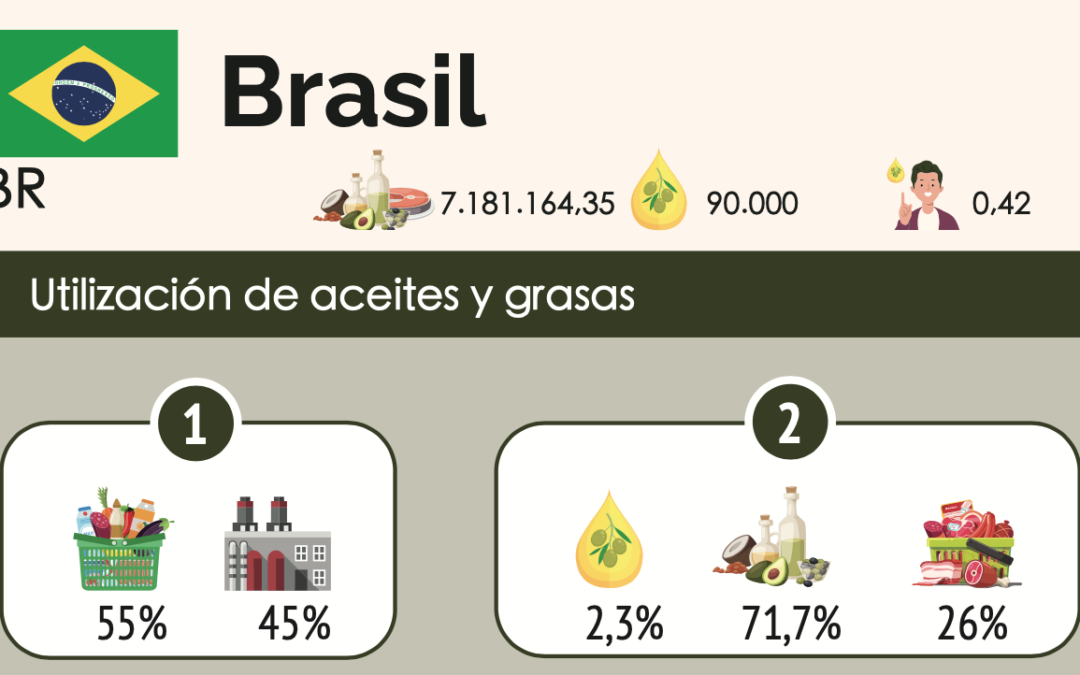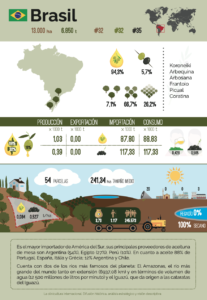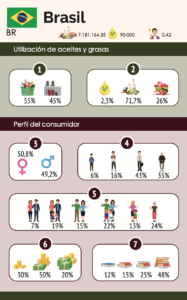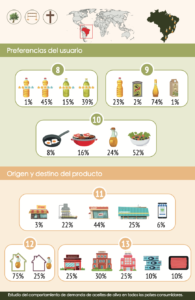Brazil is located in South America and has about 212 million inhabitants. It has two of the most famous rivers on the planet: the Amazon, the largest river in the world both in terms of length (6937.08km) and in terms of water volume (12.5 billion liters per minute) and the Iguazu, which gives rise to Iguazu Falls. The largest number of olive plantations in Brazil is in the south of the country.
Brazil ranks 32nd in terms of area under cultivation, with 13,000 hectares. It also ranks 32nd in olive oil production among the 66 producing countries, as well as 35th in table olive production.
The most predominant types of olive groves in this country are high density ones, amounting to 66.7% of the total crop. This is followed by the super high density groves accounting for 26.2%, and finally, traditional cultivation systems account for 7.1%. In addition, there are no hectares of rainfed olive groves, so the crop is exclusively irrigated.
The percentage of olive grove production for olive oil production is 94.3% and the remaining 5.7% for table olives. The most predominant varieties in this area are: Koroneiki, Arbequina, Arbosana, Frantoio, Picual and Coratina.
Of the total olive oil production, 68% could be classified as high quality oil, producing virgin or extra virgin olive oil. The remaining 32% is classified as lower quality oil, such as lampante olive oil.
Brazil is the largest importer in South America. It imports around 87,900 tons of olive oil and 117,330 tons of table olives. Its main suppliers of table olives are Argentina (54%), Egypt (27%), Peru (10%). As for olive oil, 88% comes from Portugal, Spain, Italy and Greece, whereas 12% comes from Argentina and Chile.
It has 54 with an average size of approximately 241.34 ha. Productivity per hectare is 0.084 tons of olive oil and 0.527 tons of table olives.
It has 20 olive mills and 3 table olive factories, but no olive pomace plants or refineries.
The country’s turnover generated by the olive sector is 3.73 million euros. The annual number of working days in the olive oil sector and related industries is 245,573.
Of the total of edible animal and vegetable fats, 2.3% olive oil is consumed, which represents about 90,000 tons. The per capita consumption per person is 0.42 liters of olive oil.
With respect to the consumer profile, the percentage of women who consume olive oil is 50.8%. However, men account for a slightly lower percentage than women, standing at 49.2%.
As for the consumption according to the age ranges of the population, people between 34 and 49 years old consume the highest percentage, amounting to 43%, followed by people over 65 years old with 35%. People under 34 years of age consume the smallest amount of olive oil in the country.
According to the family structure, a higher percentage of olive oil is consumed in middle-aged families with children, followed by young families with children. In contrast, families without children do not consume any significant amount of oil.
With respect to the level of income, individuals who have an average income consume a higher percentage of olive oil, amounting to 50%. On the other hand, those who have high incomes consume the smallest percentage of olive oil.
Those who have a more advanced academic education,such as university or postgraduate studies, consume olive oil more than those without these qualifications. Thus, consumption among those with higher education is around 48%.
In terms of user preferences, 45% prefer to consume olive oil, followed by 39% who prefer to consume extra virgin olive oil.
The most commonly used container in Brazil for olive oil consumption is glass with 74%, followed by PET with 23%.
According to the use for which the olive oil is intended for, it is most commonly used for seasoning salads, or other raw applications. This accounts for 53% of its use. The lowest proportion of olive oil is used for frying, at 8%.
Most people buy olive oil in supermarkets (44%), followed by hypermarkets (25%). Olive oil is least purchased in traditional stores.
Seventy-five percent of users consume olive oil in their own homes, the remaining 25% do so outside the home. Outside the home, it is predominantly done in collective establishments, hotels, as well as bars and restaurants.




